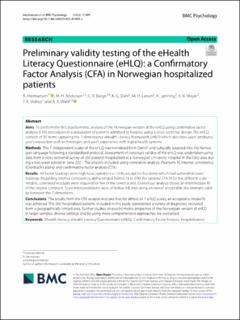| dc.contributor.author | Hermansen, Åsmund | |
| dc.contributor.author | Andersen, Marit Helen | |
| dc.contributor.author | Borge, Christine Råheim | |
| dc.contributor.author | Dahl, Kari Gire | |
| dc.contributor.author | Larsen, Marie Hamilton | |
| dc.contributor.author | Lønning, Kjersti | |
| dc.contributor.author | Meyer, Käthe Birgitte | |
| dc.contributor.author | Vidnes, Tone Karine | |
| dc.contributor.author | Wahl, Astrid Klopstad | |
| dc.date.accessioned | 2023-12-19T14:18:27Z | |
| dc.date.available | 2023-12-19T14:18:27Z | |
| dc.date.created | 2023-11-15T11:35:46Z | |
| dc.date.issued | 2023 | |
| dc.identifier.citation | Hermansen, Å., Andersen, M. H., Borge, C. R., Dahl, K. G., Larsen, M. H., Lønning, K., ... & Wahl, A. K. (2023). Preliminary validity testing of the eHealth Literacy Questionnaire (eHLQ): a Confirmatory Factor Analysis (CFA) in Norwegian hospitalized patients. BMC psychology, 11(1), 409. | en_US |
| dc.identifier.issn | 2050-7283 | |
| dc.identifier.uri | https://hdl.handle.net/11250/3108249 | |
| dc.description.abstract | Aims: To perform the first psychometric analysis of the Norwegian version of the eHLQ using confirmative factor analysis (CFA) procedures in a population of patients admitted to hospital using a cross-sectional design. The eHLQ consists of 35 items capturing the 7-dimensional eHealth Literacy Framework (eHLF) which describes users' attributes, user's interaction with technologies and user's experience with digital health systems.
Methods: The 7 independent scales of the eHLQ was translated from Danish and culturally adapted into the Norwegian language following a standardised protocol. Assessment of construct validity of the eHLQ was undertaken using data from a cross-sectional survey of 260 patients hospitalized at a Norwegian University Hospital in the Oslo area during a two-week period in June 2021. The analysis included using correlation analysis (Pearsons R), internal consistency (Cronbach’s alpha) and confirmatory factor analysis (CFA).
Results: All factor loadings were high to acceptable (i.e. > 0.6), except for five items which had somewhat lower loadings. Regarding internal consistency, alpha ranged from 0.73 to 0.90. For optimal CFA fit for the different scale models, correlated residuals were required for five of the seven scales. Overall our analysis shows an intermediate fit of the orginal construct. Scale intercorrelations were all below 0.8, indicating an overall acceptable discriminant validity between the 7 dimensions.
Conclusions: The results from the CFA analysis indicate that for almost all 7 eHLQ scales, an acceptable model fit was achieved. The 260 hospitalized patients included in this study represented a variety of diagnoses, recruited from a geographically limited area. Further studies on psychometric properties of the Norwegian version of eHLQ in larger samples, diverse settings and by using more comprehensive approaches are warranted. | en_US |
| dc.language.iso | eng | en_US |
| dc.rights | Navngivelse 4.0 Internasjonal | * |
| dc.rights.uri | http://creativecommons.org/licenses/by/4.0/deed.no | * |
| dc.title | Preliminary validity testing of the eHealth Literacy Questionnaire (eHLQ): A Confirmatory Factor Analysis (CFA) in Norwegian hospitalized patients | en_US |
| dc.title.alternative | Preliminary validity testing of the eHealth Literacy Questionnaire (eHLQ): A Confirmatory Factor Analysis (CFA) in Norwegian hospitalized patients | en_US |
| dc.type | Peer reviewed | en_US |
| dc.type | Journal article | en_US |
| dc.description.version | publishedVersion | en_US |
| dc.rights.holder | © The Author(s) 2023. | en_US |
| dc.source.volume | 11 | en_US |
| dc.source.journal | BMC Psychology | en_US |
| dc.source.issue | 1 | en_US |
| dc.identifier.doi | 10.1186/s40359-023-01449-z | |
| dc.identifier.cristin | 2196982 | |
| dc.source.articlenumber | 409 | en_US |
| cristin.ispublished | true | |
| cristin.fulltext | original | |
| cristin.qualitycode | 1 | |

